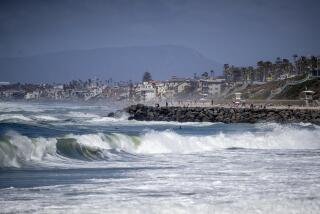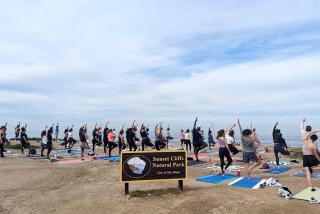Oceanside Will Dim Some Lights for Palomar : Science: City Council OKs ordinance for low-pressure sodium lighting to become county’s fifth city to help reduce light pollution for observatory.
- Share via
Oceanside became the fifth city in San Diego County to mandate the use of low-pressure sodium lights as a way of protecting Palomar Mountain Observatory from light pollution when it adopted a light ordinance Wednesday to aid what one official called “the search for the secrets of the universe.”
The Oceanside City Council passed the ordinance, which is limited largely to new construction, by a 5-0 vote, joining the city and county of San Diego, Escondido, Vista and Poway as municipalities with similar regulations.
The measure passed with no one speaking against it and with virtually no discussion.
Deputy City Manager Dana Whitson said the ordinance deals only with outside lighting and does not include city street lights, except in new developments. Whitson said it would not be cost-effective--at the moment--to convert Oceanside’s existing street lights from high-pressure to low-pressure sodium.
She said the city is attempting to buy street lights owned by San Diego Gas & Electric, and it will not be feasible to explore a full-scale conversion to low-pressure sodium lighting until negotiations are completed.
However, she noted that the city of San Diego now saves at least $500,000 annually as a result of converting to low-pressure sodium street lights, a process begun in 1982.
Oceanside’s ordinance pertains to new development and to existing businesses, which will be allowed to use high-pressure sodium lighting, but only until 11 p.m. And even then, Whitson said, such lights will have to be shielded, to reduce or eliminate the glare.
Merchants wanting all-night lighting as a security measure will have to confine themselves to low-pressure sodium lights between 11 p.m. and dawn, she added, with new businesses being completely restricted to low-pressure sodium as a lighting source.
Robert J. Brucato, the assistant director of Palomar Mountain Observatory, hailed Wednesday’s vote as an aid in scientific discovery. Brucato said that, because many of the objects viewed by Palomar’s 200-inch Hale Telescope are so faint, “light pollution” makes the process all but impossible.
He said that, unlike so-called white lights, which emit a bluish glare, or high-pressure sodium lights, which emit an intense pink-yellow glare, low-pressure sodium lights do not obscure the distant light of stars and galaxies.
Brucato said the observatory was opened in 1948, when no one could have predicted the growth of the areas surrounding Palomar Mountain.
“If you look at the population curves, Riverside, San Diego, Orange and Los Angeles counties have undergone exponential growth,” Brucato said. “It isn’t just linear growth--it exploded after World War II. It was way beyond anything anybody anticipated.”
Brucato said that existing light pollution “slows us down a bit, but it’s not intolerable. The purpose of our present exercise--and why I was here (Wednesday)--is to see that it doesn’t get any worse.”
Brucato said municipalities have been cooperative with the Pasadena-based California Institute of Technology, which owns the observatory, and several cities in the state--Redwood City, Santa Maria, Norwalk and Long Beach--have converted to low-pressure sodium street lights simply because they’re cheaper.
He said the Riverside County cities of Hemet, Temecula and the community of Winchester have recently adopted ordinances similar to Oceanside’s, and even long portions of Interstate 15 are now dotted with low-pressure sodium lights.
Brucato said light pollution remains “a very real concern” throughout astronomical research, noting that the Mt. Wilson Observatory in the San Gabriel Mountains is simply not able to match Palomar’s research because the light problem there constitutes “an extreme case.”
More to Read
Sign up for Essential California
The most important California stories and recommendations in your inbox every morning.
You may occasionally receive promotional content from the Los Angeles Times.













